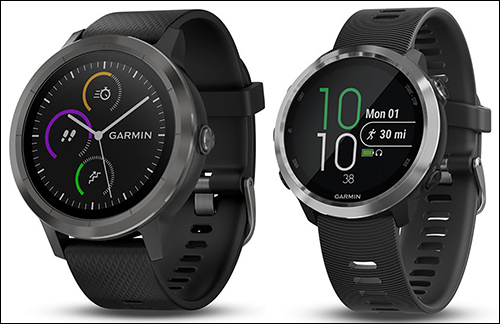NXP Semiconductors and wearable technology company Garmin International have teamed up to offer Near Field Communication (NFC) payment capability in the latter’s mobile payment solution, known as Garmin Pay, built into several sports-based wristband products. The vivoative 3 and Forerunner 645 Music watches each come with a built-in NXP 13.56 MHz NFC PN802 embedded Secure Element (SE) micro controller circuit compliant with the ISO 14443 standard. The wristbands can then be used with NFC readers at the point of sale (POS) to accomplish payments without the need for a credit card or wallet.
In addition to the NFC-based hardware, NXP, based in Eindoven, the Netherlands, is also providing its Loader Service solution to Garmin Pay-based devices that integrate payment transactions with the Garmin Pay wallet, powered by Fit Pay Inc. The solution ensures a secure payment for users, says Charles Dachs, NXP’s VP and general manager of secure embedded transactions.
The vivoactive 3 has been commercially available in most areas of the world since September 2017, while the Forerunner 645 Music was announced in January of this year and is expected to be released to consumers soon, according to Nate Ahuna, Garmin International’s business-development manager.
The vivoactive 3 is a GPS-enabled smart watch that tracks a wearer’s heart rate and activity level, as well as the time, while also enabling contactless payments. Setup is accomplished in the Garmin App. A user can simply download the app, tap Garmin Pay, make sure the system is available in his or her area and then set up the wallet. To do this, a person would need to enter a four-digit password, then add at least one credit card number to the wallet (which can be used for payments), or scan the code with the phone’s camera. Once the data has been verified, it is stored in the wallet.
To make a payment, a user presses and holds the action button to bring up the control menu on the watch’s face. He or she is prompted to enter the password, after which the wallet appears on the screen of the watch. The user then holds the wristband within close range of a Garmin Pay POS device, which captures the tag ID number and payment information, and the Garmin system deducts the appropriate funds for that purchase from his or her account.
The Forerunner 645 Music watch is intended for runners, the companies report. A user can download up to 500 songs onto the watch, connecting to headphones via Bluetooth. It also enables the activity-tracking functionality and the same Garmin Pay contactless payment solution.
The NXP Secure Element embedded in the devices is a piece of hardware intended to safeguard payment information in the wristband, and to ensure the safe transaction of data. That data, with the Loader Service solution, can then be added to a payment app, such as Garmin Pay. The Loader Service itself is preconfigured on the SE to provide the protection and encryption of data coming from the wristband, including the unique ID.
“Garmin Pay is a tremendously important feature to customers who value an active lifestyle,” Ahuna says. “It allows them the freedom of living an active lifestyle untethered from their phone and wallet, and to make purchases on the go.”
When Garmin began considering NFC technology options, Ahuna says, the company found that NXP’s SE system enables not only secure payments, but other contactless NFC-based services as well. “Garmin Pay is still our main priority relative to improving coverage across the globe,” he states, “but we are absolutely investigating NFC in other products, as well as items adjacent to payment,” such as access control.
In the meantime, Dachs says, the Loader Service was released about a year and a half ago, to provide a security layer for transactions using data linked to debit or credit card information, on wristbands or other wearable devices. NXP also offers a software developers kit (SDK) for companies setting up payment systems that can be used with the Garmin Pay-enabled device. The Loader Service can be used on wristbands such as activity trackers, as well as on smart jewelry and mobile phones, and is intended to simplify and secure the process of establishing payment systems linking to companies like MasterCard and Visa. To date, Dachs says, “There are more than 30 projects [under way]” that use NXP’s Loader Service solution. However, Garmin has moved more quickly than some with its solution. In fact, he says, “Garmin was able to enable this deployment in record time.”
Usage by consumers will ramp up slowly, Dachs predicts, as a growing number of retailers and other businesses incorporate Garmin Pay NFC-enabled payment systems at their point of sale. That will require participation by banks.
“Proliferating coverage of Garmin Pay, at this point, is primarily dependent on a bank’s willingness to participate,” Ahuna states, “and we’ve had a significant number of conversations around the globe.” He adds, “All banks have shown significant interest in the solution thus far, which is very positive.” At present, there are banks participating in the United States, Australia, Switzerland, Russia, Denmark, Finland, Sweden and Norway, with more to come throughout this year.


